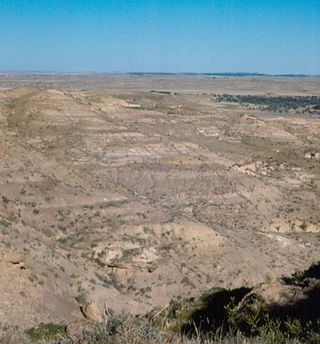
The Lance (Creek) Formation is a division of Late Cretaceous rocks in the western United States. Named after Lance Creek, Wyoming, the microvertebrate fossils and dinosaurs represent important components of the latest Mesozoic vertebrate faunas. The Lance Formation is Late Maastrichtian in age, and shares much fauna with the Hell Creek Formation of Montana and North Dakota, the Frenchman Formation of southwest Saskatchewan, and the lower part of the Scollard Formation of Alberta.
The Twin Mountains Formation, also known as the Twin Mak Formation, is a sedimentary rock formation, within the Trinity Group, found in Texas of the United States of America. It is a terrestrial formation of Aptian age, and is notable for its dinosaur fossils. Dinosaurs from this formation include the large theropod Acrocanthosaurus, the sauropod Sauroposeidon, as well as the ornithopods Tenontosaurus and Convolosaurus. It is the lowermost unit of the lower Cretaceous, lying unconformably on Carboniferous strata. It is overlain by the Glen Rose Formation. It is the lateral equivalent of the lower part of the Antlers Formation.

The Arundel Formation, also known as the Arundel Clay, is a clay-rich sedimentary rock formation, within the Potomac Group, found in Maryland of the United States of America. It is of Aptian age. This rock unit had been economically important as a source of iron ore, but is now more notable for its dinosaur fossils. It consists of clay lenses within depressions in the upper part of the Patuxent Formation that may represent oxbow swamp facies. It is named for Anne Arundel County, Maryland.
The Lura Formation is a geological formation in western China, which outcrops in Tibet, whose strata date back to the Early Cretaceous. Dinosaur remains are among the fossils that have been recovered from the formation.
The Dashuigou Formation is a geological formation in Inner Mongolia, north China, whose strata date back to the Early Cretaceous period.
The Ulansuhai Formation is a geological formation in Inner Mongolia, north China. Dinosaur remains are among the fossils that have been recovered from the formation.
The Yijinholuo Formation is a geological formation in Inner Mongolia, China whose strata date back to the Early Cretaceous. Dinosaur remains are among the fossils that have been recovered from the formation.
The Ashville Formation is a geological formation in Saskatchewan and Manitoba whose strata date back to the Late Cretaceous. Dinosaur remains are among the fossils that have been recovered from the formation.
The Denver Formation is a geological formation that is present within the central part of the Denver Basin that underlies the Denver, Colorado, area. It ranges in age from latest Cretaceous (Maastrichtian) to early Paleocene, and includes sediments that were deposited before, during and after the Cretaceous-Paleogene boundary event.

The Eagle Sandstone, originally the Eagle Formation, is a geological formation in Montana whose strata date back to the Late Cretaceous. It is a light to brownish gray to pale yellow-orange, fine-grained sandstone. It contains areas of crossbedding and local shale members. It contains large sandy calcareous concretions. Its thickness varies from 100 to 350 feet due to the lens nature of the individual sandstone layers and local interbedded sandy shale layers.
The Claggett Shale is a geological formation in Montana whose strata date back to the Late Cretaceous. Dinosaur remains are among the fossils that have been recovered from the formation.

The Frontier Formation is a sedimentary geological formation whose strata date back to the Late Cretaceous. The formation's extents are: northwest Colorado, southeast Idaho, southern Montana, northern Utah, and western Wyoming. It occurs in many sedimentary basins and uplifted areas.
La Bocana Roja Formation is a geological formation in Baja California, Mexico whose strata date back to the Late Cretaceous, althought the precise age is unclear. Dinosaur remains are among the fossils that have been recovered from the formation.
The Gres de Saint-Chinian is a geological formation in Aude and Hérault, France whose strata date back to the Late Cretaceous. Dinosaur remains are among the fossils that have been recovered from the formation.
The Trichinopoly Group is a geological formation in India whose strata date back to the Late Cretaceous. It lies between the Ootatoor and Ariyalur Groups. It is broad in its southern extremity but thins as it gradually proceeds northwards as it ultimately meets the Ariyalur Group. Dinosaur remains are among the fossils that have been recovered from the formation.
The Shanyang Formation is a geological formation in Shaanxi whose strata date back to the Late Cretaceous. Dinosaur remains are among the fossils that have been recovered from the formation.
The Minhe Formation is a geological formation in northwestern China, whose strata date back to the Late Cretaceous period.
The Huiquanpu Formation is a geological formation in Shanxi and Hebei provinces, China, whose strata date back to the Late Cretaceous period. It predominantly consists of purple-red mudstone, with subordinate grey-white sandy conglomerates.
The Yuliangze Formation, or Yuliangzi Formation, is a geological formation in Heilongjiang, China whose strata date back to the early-middle Maastrichtian. Dinosaur remains are among the fossils that have been recovered from the formation.
The Xiaoyan Formation is a geological formation in Anhui, China whose strata date back to the Late Cretaceous. Dinosaur remains are among the fossils that have been recovered from the formation. It overlies the older Qiyunshan Formation which it forms the Huangshan Basin with, and was deposited between the Campanian and Maastrichtian stages.



